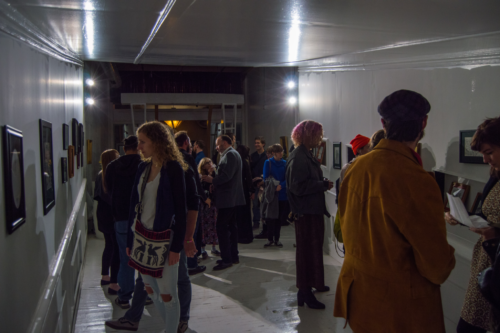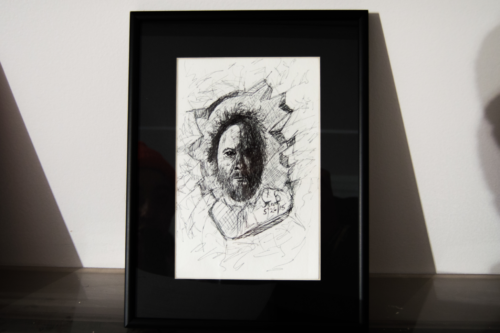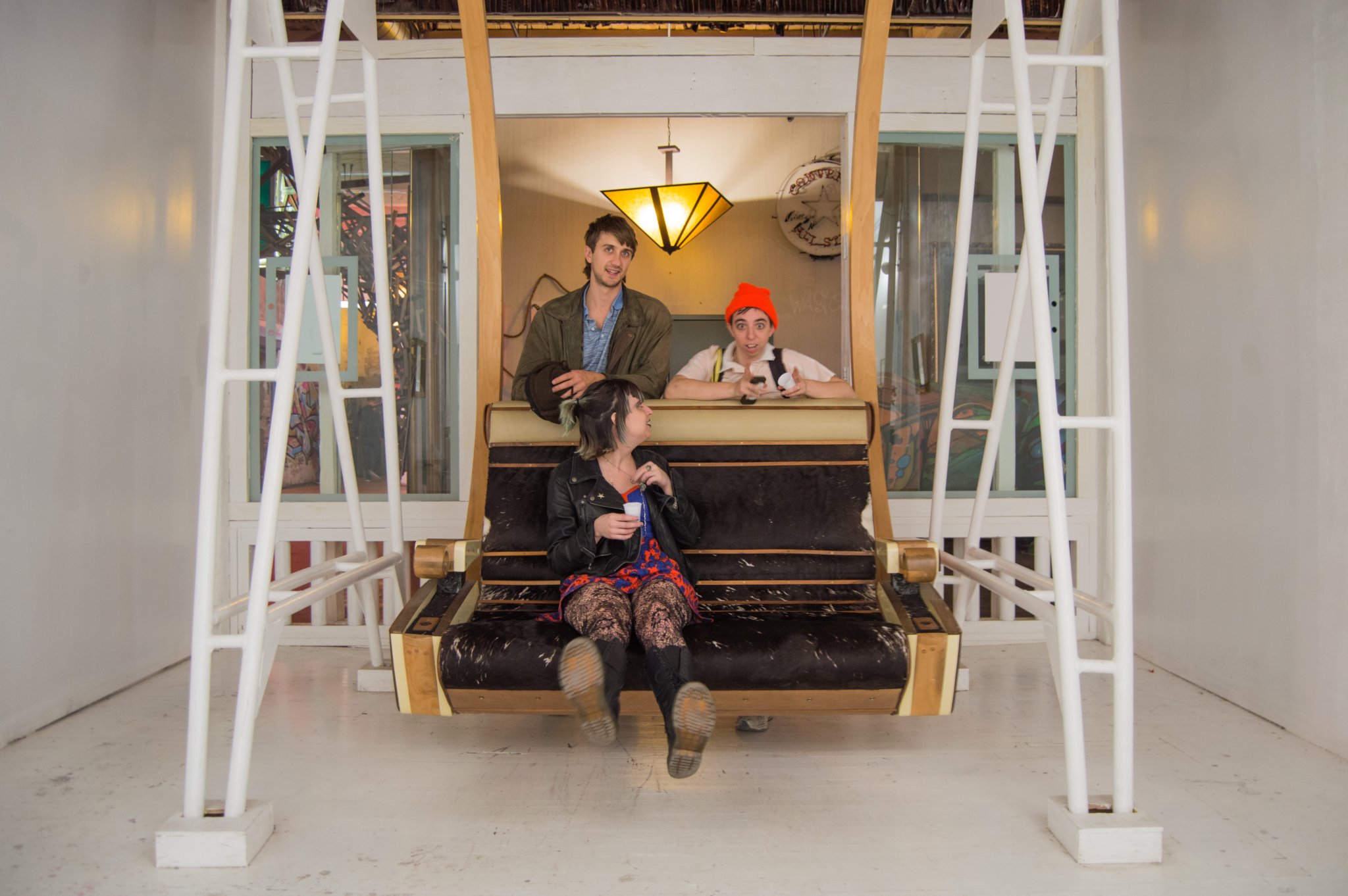On the first floor of the Lacuna Artists Lofts, near the abstract floating reclaimed wood sculpture, past the neon Converse All-Stars wall hanging, around the eleven-foot-tall vintage cowhide couch-swing with USB port armrests, you enter a narrow room.
“Join us at Lacuna Artist Lofts for ART PARTY, our monthly second Friday art opening. The October feature is the first solo exhibition of works by Steve Badauskas,” reads Lacuna’s e-vite for their October Art Party.
“Ah, yes, Steve Badauskas,” thinks an art connoisseur, in Hyde Park, or West Loop. “I think I’ve heard that name.”
“Ah, yes, Steve Badauskas,” thinks a multitude of Bridgeporters, “Steve’s having a show? I gotta go!”

The room: bright white yet dimly lit, thirty-two drawings hung with dollhouse simplicity upon the walls and squeezed onto the shelves. The gallery has optical illusive proportions—it distorts reality. It gives the viewer the feeling of a passenger train car, a living room, a scene from a passing dream.
The show at Lacuna, The Longest Night That Ever Was, is all pen, ink, and marker on paper, mostly black and white, with minimal splashes of color. The three-hour opening was on October 14. The room was pleasantly crammed with visitors and well-wishers, including one man who proclaimed he would have “rise[n] from his deathbed” to attend the event.
Who is Steve Badauskas? Why did his opening have hordes of attendees and raise the dead? Why were there bustling sales of pieces that night, when your classic tatterdemalion artist goes home from a first solo show with breadcrumbs and stale water?
Steve Badauskas is a neighborhood fixture in Bridgeport. He’s the proprietor of Bernice’s, a watering hole that has been open for fifty-one years, located at 32nd and Halsted. You’ve seen it on “Best Of” lists.
Bernice’s is low-ceilinged, has the feeling of a train car, a living room, a dream. People come to Bernice’s for advice, sanctuary, and “night before the wedding” pep talks. Steve has a quiet passion.

“Steve has showed individual pieces here and there for the past ten years, but when I found out he hadn’t had his own show, I knew I had to ask him to be our monthly feature,” says Elizabeth Isakson-Dado, his curator at Lacuna. “About a year ago the building [Lacuna Artist Lofts] approached me, I own a print shop called Felix Tandem Letterpress upstairs, which is how I met Steve, and the building asked us to help put together monthly events to draw people to Lacuna.”
A “lacuna” is a “gap or blank space in something: a missing part.” Fitting that Steve’s first solo show would be at a gallery by that name. Art is his missing part.
“When Steve first came to our workshop to print with us, I slowly started to realize how big of a part art was in his life,” says curator Isakson-Dado.
Art is not only part of his life, but of his life beyond life. His art is a reflection of the unfathomable depth of the subconscious.
Many people—perhaps it is more accurate to say patrons, friends—at the event describe scenes of Steve sketching and drawing while watching over Bernice’s, using the bar top as a drafting board. He has shyly shown the occasional piece, or else promised to show a piece to a friend before quietly backing out.

“Steve has two different styles,” says Isakson-Dado. “One is ‘pre-drawn paper,’ which means he draws what he sees in the grain of the paper. The other is the ‘dream world.’”
Isakson-Dado says that sometimes he’ll have images that he can’t get out of his head, images that return to him night after night in dreams, and in waking hours.
The exhibition’s title, The Longest Night That Ever Was, is in reference to Steve’s affliction masquerading as muse, insomnia.
His curator describes Steve’s style as similar to that of sketchy Brit Sue Coe, or of 14th-century Netherlander Hieronymus Bosch, the latter more for the subject matter than style. The empathetic simplicity in Badauskas’s more restrained pieces reminded me of Shel Silverstein. A gesturally drawn young girl on a sea shore (Girl With Wagon, $160), for instance. A small boat in a dense-tropical setting (Bangkok Blues, $120), for example.
These two small drawings are emblematic of the “waking dream” category described by Isakson-Dado. The other half of the show is the Boschers, the “pre-drawns,” as she described them—pieces straight from Dante’s inferno. Faces on faces, drawn with black-penned, feverish devilry.
The title piece of the show, at the back of the room, where the walls began to draw close to the ground, was The Longest Night that Ever Was. The picture depicts a man in an armchair, oddly smudged light blue letters floating above him, the only use of this color. He is facing a TV and beset on all sides by intense devilish darkness, featureless figures surrounding his small area of “light.”
As Steve said, “Many of these pieces came from a very dark time in my life, which is where I was able to gather the inspiration that created them. But I hope to never go to those places again, and I don’t wish for anyone else to go there.”
Badauskas posed next to the aforementioned piece for the Weekly’s photographer, and smiled with the genuine peace and happiness that is afforded to those who have been surrounded by well-wishers for three hours straight. There was no trace of darkness on that night.

